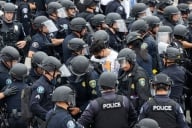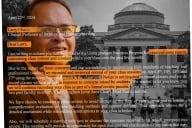You have /5 articles left.
Sign up for a free account or log in.
When police arrested 4 Wesleyan University students on Tuesday in connection to “a bad batch” of the club drug Molly that sent 10 students and 2 others to hospitals, those charged joined an elite cohort: the small number of Wesleyan students arrested for drug violations.
In 2012 and 2013, the last two years of available federal data, 521 Wesleyan students were referred to campus officials for disciplinary action involving drug use on campus. Only four students were arrested.
At a time when Wesleyan students and others are considering what more could be done to prevent drug overdoses, the statistics raise questions. At the same time, they are typical of small private colleges. But a review of federal crime reports shows that larger, public universities are much more likely than colleges like Wesleyan to arrest drug offenders, not just refer them for disciplinary action.
At Wesleyan, officials defended their approach.
"We are committed to responding to violations with education, treatment and sanctions, as appropriate,” Dean Michael Whaley, vice president for student affairs, said in a statement. “These federal statistics reflect our vigorous efforts to enforce our policies. At Wesleyan, we don't sweep these problems under the rug.”
Wesleyan is not alone in its low number of arrests resulting from students being caught using drugs, but it's not in the majority, either. Across the country, institutions vary widely in which cases of drug use become police matters and which ones stay on campus.
Small, private liberal arts colleges tend to have low number of arrests, even with proportionately high numbers of disciplinary referrals. At Colgate University, 245 students in 2012 and 2013 were referred for disciplinary action for drug abuse violations, and 6 were arrested. In that same time span, Oberlin College referred 198 students, while 5 were arrested. It’s a similar story at Kenyon College, Reed College and Occidental College: student arrests were in the single digits; disciplinary referrals were in the hundreds.
In 2013, private, four-year institutions with enrollments of fewer than 5,000 referred more than 14,000 students for disciplinary action for drug violations. Fewer than 2,000 students were arrested.
"There is a philosophy for minor drug offenses on some campuses that emphasizes the educational process of helping students learn from their mistakes without the outcome of a criminal record,” said Kevin Kruger, president of NASPA: Student Affairs Administrators in Higher Education. “Of course, this depends on the severity and would mostly be cases of individual use for the first time. When campuses find students in possession of amounts that are used for sale, there is little tolerance and those cases may involve coordination with campus law enforcement.”
Certain hard drugs, such as heroin or methamphetamine, can invoke a police response even for possession, said Laura Bennett, president of the Association for Student Conduct Administration. But the majority of referrals for drug use are "lower level," she said, and if they result in a sanction at all, it's typically "an educational outcome," such as being required to take a course about abuse or to participate in community service.
"The focus of the conversation is very different," Bennett said. "It's not 'You broke the law. Here's your consequence.' The conversation is about the student's usage. It's about helping the student make better choices. Just because you have a beer or smoke a joint, that's not necessarily grounds to say you can't come to school here anymore. Sometimes the criminal justice system is not the place for really addressing that effectively."
William Holder, a spokesman for Wesleyan, declined to explain how the university decides what kind of punishment is appropriate, saying only that administrators consider "a variety of potential sanctions, as well as educational measures, depending upon the facts of individual cases.”
It can be a different story at large, public institutions -- particularly those that use sworn campus police officers rather than security forces, and where police are more likely to be the first to respond to misconduct. Nearly 70 percent of colleges and universities with enrollments higher than 2,500 now operate full law-enforcement agencies, according to the Bureau of Justice Statistics.
In 2013, public, 4-year universities with enrollments of 20,000 or higher referred 13,600 students for drug abuse violations. Nearly 8,500 students were arrested. At institutions such as San Diego State University, the University of Alabama at Tuscaloosa and the University of Michigan at Ann Arbor, the numbers of disciplinary referrals and arrests for drug use are nearly equal.
At a number of large universities, however, arrested students actually outnumber students who are referred for disciplinary action. Between 2011 and 2013, 537 students at the University of California at Berkeley were arrested for drug use on campus, and 254 were referred for disciplinary action. At the University of Georgia, 42 students received disciplinary referrals, while there were nearly 200 arrests.
During that same 3-year time span, Florida State University referred just 32 of its 40,000 students for disciplinary action for drug use on campus. More than 400 students were arrested.
“Our process is to enforce the laws as they are outlined with each chapter of our Florida statute,” David Perry, chief of police at FSU, said. “We try not to apply uneven discretion in drug cases. It’s pretty straightforward. We’re there to enforce the laws.”
Perry is also the president of the International Association of Campus Law Enforcement Administrators. He said the association's members use whatever resources are available to them for sanctioning students. At colleges and universities with sworn police officers, that means arresting and prosecuting students if necessary. At smaller colleges with public safety officials, that largely means referring students to the campus judicial system.
At FSU, some of the arrested students are also referred to the university for additional disciplinary action, Perry said, but students who are caught by university employees rather than campus police rarely have their cases referred to law enforcement unless the incident is putting other students at risk.
Bennett, of ASCA, said while some argue that colleges shouldn’t be adjudicating criminal misconduct, she doesn’t see it that way. There’s room for both processes, she said.
“Some do say colleges shouldn’t be addressing some of these things, and that they’re best left to the courts,” Bennett said. “I really go back to that it can be both, not necessarily either-or. Our process is not determining if a student broke a law, but if a student has violated our policies or is putting other students in danger. College policies should be focused on what it means to be a member of the campus community.”








